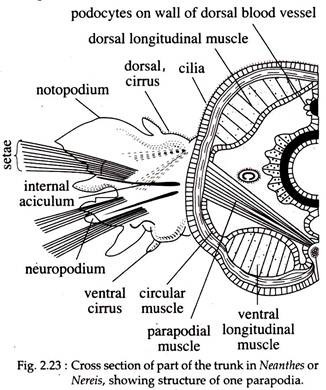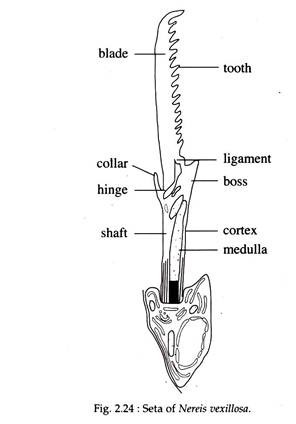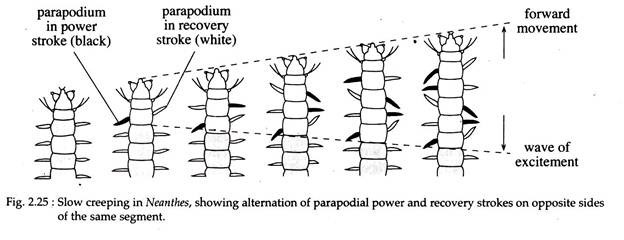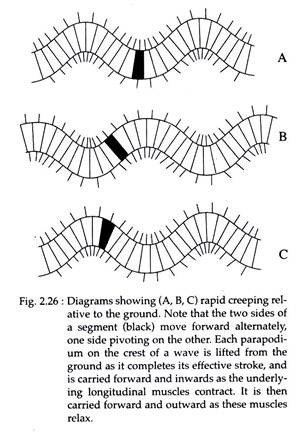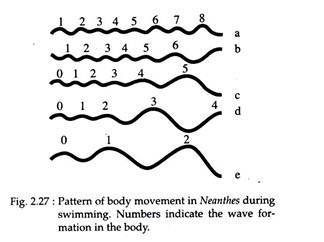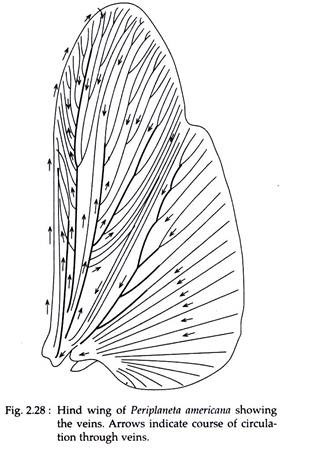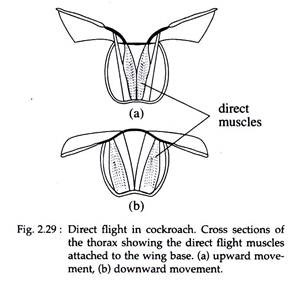In this article we will discuss about Parapodal Locomotion in Neanthes:- 1. Introduction to Neanthes 2. Different Types of Locomotion in Neanthes 3. Musculature Related to Locomotion 4. Locomotion in Cockroach with the Help of Wings.
Introduction to Neanthes:
Nereis or Neanthes is an example of ‘errant’ form of polychaetes because of their free-moving mode of life. The worms belonging to this genus exploit diverse habitats like Nereis vitabunda of Sumatra is a terrestrial form living in soil channels, N. diversicolor lives in fresh water.
Most species like N. dumerilii, N. virens, N. japonica, are marine, crawling and swimming beneath stones, shells, crevices in sand and within sea weeds. Two structural elements are especially important in the locomotion of Neanthes – the longitudinal muscles of the body wall and the parapodia.
Parapodia in Neanthes:
ADVERTISEMENTS:
Parapodia are fleshy, paddle like locomotory appendages, arising from the lateral side of the body segments in polychaetes. In Neanthes, all body segments except the first and last segments bear on either lateral side the parapodia. Largest parapodia are encountered in the middle segments of the body. The size of parapodia decreases towards the two ends.
Each parapodium is biramous, consisting of an upper division, the notopodium, and a ventral division, the neuropodium. Each division is supported internally by one or more chitinous rods, each called an aciculum.
The notopodium bears a tentacle like dorsal cirrus and has two conical lobes or ligules. The neuropodium has one ventral cirrus and one ligule. Each parapodial lobe contains pocket or setal sacs from which many chitinous bristles or setae arise and project beyond the end of the parapodial lobe (Fig. 2.23).
Seta:
Each seta is secreted by a single cell at the base of the setal sac or setigerous sac. New setae are continually produced by the sac as older setae are lost. Each seta consists of a basal shaft with which articulates a terminal blade (Fig. 2.24).
The shafts assume great variety of shapes and the setal bundles of a particular species may be composed of more than one type of seta. Setae are used for locomotion but may also be used for digging and gripping of tubes and burrows.
Different Types of Locomotion in Neanthes:
Neanthes generally move by slow creeping that may readily passes into rapid creeping and swimming.
ADVERTISEMENTS:
Slow Creeping:
This type of movement depends almost entirely upon the use of parapodia as a series of levers. During this movement, a parapodium is directed forward with its tip lifted from the ground and with the aciculum withdrawn. This phase of the movement constitute the preparatory stroke.
At the end of this stroke, the parapodium makes contact with the substratum, the aciculum is protruded, and the oblique muscles contract so that the body is pulled forward. The parapodium, which comes to be directed backward during this phase, is now exerting its power stroke.
After the backward stroke of the parapodium, the acicula as well as setae are retracted and the parapodium again lifts off the substratum and swings forward. The tip of the parapodium, thus describes an ellipse in one cycle of the stroke. The movements of the parapodium are integrated so that the two members of any one segmental pair alternate with each other in phases.
When a particular parapodium on one side is executing an effective stroke, the parapodium on the opposite side is executing the recovery stroke (Fig. 2.25). Moreover, the movement of any one para-
podium begins slightly after that of the one next behind it.
The actions are thus seen as waves of movement that travel forwards over the length of the body. In Neanthes, when this movement is initiated, a wave of activation sweeps along the worm affecting every fourth to eighth segment.
Rapid Creeping:
Slow creeping readily passes into rapid creeping. It involves a similar rhythmic pattern of waves like that in slow creeping, but with the difference that the longitudinal muscles of the body wall are now of primary importance. The muscles contract serially in parallel with the movements of the parapodia.
ADVERTISEMENTS:
The contractions of the longitudinal muscles throw the body into lateral sinusoidal waves that pass anteriorly along its length. At any given moment, a parapodium on the crest of a wave, where the longitudinal muscles are relaxed, is stationary with respect to the substratum.
The parapodium on the opposite side of the segment is in the trough of the wave, having moved there as the longitudinal muscles contract (Fig. 2.26).
During this contraction the muscles exert a thrust on the substratum, but this is transmitted through the stationary parapodium on the opposite side. Actually the parapodia on the crests are not entirely inactive, as they exert their own power stroke through their adductor muscles.
This force is added to that produced by the contraction of the longitudinal muscles of opposite side. These combined forces permit the Neanthes to crawl or creep rapidly.
Swimming:
A third type of movement i.e., free-swimming, is also shown by Neanthes and that is essentially the same as that of rapid creeping. Here, the sinusoidal waves of the body interact with parapodial movement, but there is a marked increase in the length of the waves and also in their amplitude and frequency (Fig. 2.27).
So the worm is propelled forward by body waves that also pass forward. The parapodia move backward during their active stroke and so, by creating a backward flow of water, they give a forward thrust to the worm’s body. The efficiency of their action is probably very low, as the progress of the worm is slow in comparison with the frequency as well as speed of the waves of propulsion.
Nevertheless, without this parapodial action, the worm would have swam backwards. Thus, the swimming of Neanthes is totally different from that of fishes, which swim forwards through the agency of waves that pass backwards and this difference is due only to the presence of parapodia.
Musculature Related to Locomotion:
Longitudinal Muscle:
In Neanthes, the longitudinal muscles of body wall do not form a continuous layer. Instead, it is broken up into two pairs, one pair dorsal and the other pair ventral (Fig. 2.23). This arrangement makes the passage of the waves of contraction along the body into a lateral undulation.
Oblique Muscles:
These extrinsic muscles originate in the mid-ventral line of the body wall and are inserted dorsally and ventrally onto the parapodium. Typically, there are two pairs of these muscles in each segment, one pair anterior and one posterior. These are so arranged that they affect the anterior and posterior beat of parapodium. Moreover, contraction of these muscles cause retraction of parapodia.
Intrinsic Muscles:
Intrinsic protractor and retractor muscles are responsible for the protrusion and withdrawal of the chaetae bundles and their supporting acicula. Besides these muscles, there are well developed acicular muscles that remain attached to the inner end of the acicula and inserted into the parapodial wall.
The parapodium in Neanthes is clearly quite versatile in its mode of action. The development of extrinsic and intrinsic musculature fore-shadow a type of movement in which, as in arthropods, a balanced system of antagonistic muscles operate upon a hydrostatic skeleton. These properties of musculature and parapodia are so integrated that it enables Neanthes to enjoy diverse habitats.
Locomotion in Cockroach with the Help of Wings:
Cockroaches (Periplaneta americana), the pterygotan insect, are fast runners. Their ability to walk rather than run and climb rapidly is regarded as the defensive mechanism. They rarely resort to flight and can fly for a short duration with the help of hind wings.
Description of Wings:
In cockroaches, the wings are modification of exoskeleton. In P. americana, two pairs of reddish brown coloured wings are present; one pair situated on the mesothorax and the other pair on the metathorax. The wings reach up to the tip of the abdomen in the females and a little beyond it in the males. The leathery mesothoracic forewings are not used in flight but serve to protect the hind wings at rest.
They are hence called wing cover or tegmina or elytra. The hind wings are thin, membranous, transparent and delicate, and used in flight (Fig. 1.118). Each wing is composed of two membranous layers of cuticle enclosing tubular tracheae. The chitin thickens around the tracheae and haemocoelomic space to form nervures or veins. These veins form effective supporting skeletal rods for the wings (Fig. 2.28).
In the mesothorax, the scutum on each side bears one anterior and one posterior tar- gal process for the articulation of the forewings. In metathorax, similar structures are also present on the lateral side of the scutum for the articulation of the hind wings.
In cockroaches, direct muscles inserted on the basal sclerites of the wings are responsible mainly for the tilting or feathering of the wings. In males, the wing muscles are opaque and pink but in females, these muscles are hyaline and white.
Circulation in Wings:
The haemolymph flows between the tracheae and the wall of the veins (Fig. 2.28). It enters the wing by the costa as a rule and returns to the body by the posterior margin, following a fairly constant path along the largest channels in the wing.
This circulation is necessary for the normal sclerotization of the wing and for maintaining the wings in a healthy condition. The parts of wing deprived of circulating haemolymph become dry, brittle and may often crack away.
Mechanism of Flight:
In cockroaches, the two pair of wings beat independently of each other, but the hind wings operate in the air turbulence created by the forewings. During flight, each hind wing articulates with the edge of the tar-gum, but its inner end rests on a dorsal pleural process which act as a fulcrum (Fig. 2.29).
Upward movement of the wings results indirectly from the contraction of vertical muscles within the thorax, depressing the tergum. Downward movement of the wings is produced directly, by contraction of muscles attached to the wing base. Thus, the flight of cockroach is direct. However, during flight, up and down movement alone is not sufficient for flight.
The wings must at the same time be moved forward and backward. During a complete cycle of a single beat, wings are held at different angles to provide both lift and forward thrust. This insect can also achieve lift by raising and lowering wing veins, thereby changing the wing shape or contour.
The raising or lowering of the wings results from the contraction of direct flight muscles attached to the base of wings. A very slight decrease in muscle length during contraction can bring about a large movement of the wings. The elastic nature of the thoracic skeleton and the joints of wing articulation also contribute to the beat motion.
Control of Flight:
In cockroaches, there is no flight control centre in the nervous system, but the eyes and sensory receptors on the antennae, head and wings provide continual feedback information for flight control.
